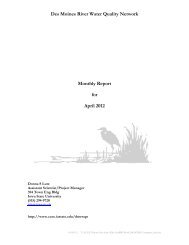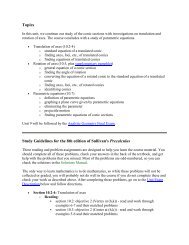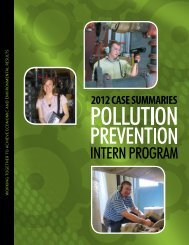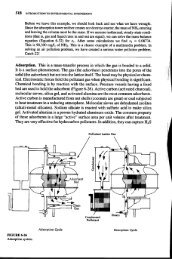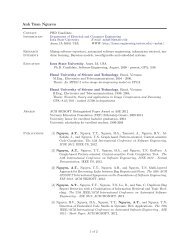DOI: 10.1126/science.1225987 , 1034 (2012); 338 Science Saran P ...
DOI: 10.1126/science.1225987 , 1034 (2012); 338 Science Saran P ...
DOI: 10.1126/science.1225987 , 1034 (2012); 338 Science Saran P ...
You also want an ePaper? Increase the reach of your titles
YUMPU automatically turns print PDFs into web optimized ePapers that Google loves.
Carbon Storage with Benefits<br />
<strong>Saran</strong> P. Sohi<br />
<strong>Science</strong> <strong>338</strong>,<br />
<strong>1034</strong> (<strong>2012</strong>);<br />
<strong>DOI</strong>: <strong>10.1126</strong>/<strong>science.1225987</strong><br />
This copy is for your personal, non-commercial use only.<br />
If you wish to distribute this article to others,<br />
you can order high-quality copies for your<br />
colleagues, clients, or customers by clicking here.<br />
Permission to republish or repurpose articles or portions of articles can be obtained by<br />
following the guidelines here.<br />
The following resources related to this article are available online at<br />
www.sciencemag.org (this information is current as of November 23, <strong>2012</strong> ):<br />
Updated information and services, including high-resolution figures, can be found in the online<br />
version of this article at:<br />
http://www.sciencemag.org/content/<strong>338</strong>/6110/<strong>1034</strong>.full.html<br />
This article cites 19 articles,<br />
1 of which can be accessed free:<br />
http://www.sciencemag.org/content/<strong>338</strong>/6110/<strong>1034</strong>.full.html#ref-list-1<br />
This article appears in the following subject collections:<br />
Ecology<br />
http://www.sciencemag.org/cgi/collection/ecology<br />
<strong>Science</strong> (print ISSN 0036-8075; online ISSN 1095-9203) is published weekly, except the last week in December, by the<br />
American Association for the Advancement of <strong>Science</strong>, 1200 New York Avenue NW, Washington, DC 20005. Copyright<br />
<strong>2012</strong> by the American Association for the Advancement of <strong>Science</strong>; all rights reserved. The title <strong>Science</strong> is a<br />
registered trademark of AAAS.<br />
on November 23, <strong>2012</strong><br />
www.sciencemag.org<br />
Downloaded from
PERSPECTIVES<br />
<strong>1034</strong><br />
joy of fi nding new facts or overturning old<br />
ones is no longer transmitted to students.<br />
As well, clinical departments have<br />
expanded geometrically as medical schools<br />
compete with private hospitals by amassing<br />
huge clinical programs. The few scientifi<br />
cally oriented faculty in clinical departments<br />
have been diluted to irrelevance by<br />
pure clinicians. No wonder that few medical<br />
students are choosing to follow paths in<br />
basic research.<br />
The research emphasis of NIH has gradually<br />
shifted. The primary focus is no longer<br />
on acquisition of knowledge in basic bio-<br />
AGRICULTURE<br />
Carbon Storage with Benefi ts<br />
<strong>Saran</strong> P. Sohi<br />
Biochar is the solid, carbonrich<br />
product of heating<br />
biomass with the exclusion<br />
of air (pyrolysis or “charring”).<br />
If added to soil on a large scale,<br />
biochar has the potential to both<br />
benefit global agriculture and<br />
mitigate climate change. It could<br />
also provide an income stream<br />
from carbon abatement for farmers<br />
worldwide. However, biochar<br />
properties are far from uniform,<br />
and biochar production technologies<br />
are still maturing. Research is<br />
beginning to point the way toward<br />
a targeted application of biochar<br />
to soils that maximizes its benefi ts.<br />
Incentives for using biomass to mitigate<br />
climate change currently focus on replacing<br />
fossil fuels in combustion. Biochar production<br />
seeks a different route to carbon abatement.<br />
By stabilizing carbon that has already<br />
been captured by plants from the atmosphere<br />
into a form resembling charcoal, it<br />
can prevent the carbon from degrading and<br />
returning to the air. A key attraction of biochar<br />
is that it can enhance the fertility and<br />
resilience of crop land. If biochar production<br />
could be made profi table through its use<br />
in agriculture, this would distinguish it from<br />
costly geoengineering measures to mitigate<br />
climate change.<br />
At least one-third of net plant growth<br />
globally is thought to be now managed by<br />
UK Biochar Research Centre, School of Geo<strong>Science</strong>s, University<br />
of Edinburgh, Edindburgh EH9 3JN, UK. E-mail:<br />
saran.sohi@ed.ac.uk<br />
logical mechanisms. Current emphasis on<br />
“translational research” relegates basic science<br />
to a back burner. What has been lost<br />
is the conviction that progress in medicine<br />
rests ultimately on a fundamental understanding<br />
of physiology. Individual curiositydriven<br />
science has been replaced by large<br />
consortia dedicated to the proposition that<br />
gathering vast amounts of correlative data<br />
will somehow provide the answer to life’s<br />
fundamental questions.<br />
Is it likely that the best and brightest<br />
medical students can be funneled into settings<br />
where they can reinforce each other<br />
Biochar variation. The diverse properties of biochar have led to widely varying<br />
results. A more systematic understanding is now emerging, helping to<br />
defi ne its value in crop production and carbon storage.<br />
humans ( 1). Diverting a few percent of this<br />
growth into biochar production could sustainably<br />
expand biosphere carbon stocks by a<br />
gigatonne [10 9 metric tons (t)] each year ( 2).<br />
In contrast, the addition of fresh or composted<br />
plant material would have a small effect on<br />
carbon storage: Only around 10% of the carbon<br />
becomes stabilized ( 3) and after reequilibration,<br />
higher levels of organic inputs to the<br />
soil are matched by more decomposition.<br />
Conversion of biomass to biochar through<br />
pyrolysis creates a product that is highly resistant<br />
to biological attack. The fi nite capacity<br />
of soils to store decomposing organic matter<br />
therefore does not apply to biochar. Exactly<br />
how long biochar remains stable in the soil is<br />
still not completely resolved, however.<br />
Calculations show that cleanly creating<br />
biochar from diffuse, seasonal sources of<br />
biomass such as rice husk should provide a<br />
clear carbon benefi t. However, biomass can<br />
often equally be used to create bioenergy<br />
23 NOVEMBER <strong>2012</strong> VOL <strong>338</strong> SCIENCE www.sciencemag.org<br />
Published by AAAS<br />
and be inspired by brilliant mentors? If it<br />
were to happen, it would require NIH to support<br />
teaching and research at a concentrated<br />
depth in the basic sciences to open the eyes<br />
of medical school graduates to the joy of scientifi<br />
c study.<br />
There is a lesson from this golden era<br />
of NIH: Ambitious young physicians juxtaposed<br />
to cutting-edge basic scientists can<br />
themselves make fundamental discoveries.<br />
Hopefully, this lesson will help to reconfi gure<br />
the future.<br />
<strong>10.1126</strong>/science.1231699<br />
Biochar—a material related to charcoal—has<br />
the potential to benefi t farming as well as<br />
mitigate climate change.<br />
and displace the use of fossil fuel.<br />
For biochar to become the better<br />
option, the effi cient stabilization of<br />
carbon into biochar must be combined<br />
with the recovery of energy<br />
from pyrolysis gases and residual<br />
heat ( 2, 4). Pyrolysis systems that<br />
connect continuous biochar production<br />
(for example, in rotating<br />
kilns) with power generation from<br />
coproducts remain scarce.<br />
Without financial incentives<br />
for carbon abatement by stabilization,<br />
biochar has to be worth<br />
money in the soil. However, biochar<br />
materials are diverse (see the<br />
fi gure), and maximizing the benefi ts gained<br />
from their use depends on matching them<br />
to the right situation ( 5). This diversity is<br />
the reason for the startling variety of results<br />
from early observational studies that aimed<br />
to demonstrate benefi ts to plant productivity.<br />
Although one study reported an eightfold<br />
increase in crop yield through the use of<br />
biochar ( 6), a meta-analysis of 16 glasshouse<br />
and fi eld studies showed a mean impact of<br />
only 10 to 15% on plant productivity ( 7). The<br />
highest productivity increases were seen in<br />
soils of medium texture and low pH.<br />
Many of these early studies used readily<br />
available charcoal, which is one form of<br />
biochar. Increasingly, biochar with particular<br />
properties is selected to address an identifi ed<br />
soil constraint, such as water storage or fl ow,<br />
pH or retention of crop nutrients, or even a<br />
biological purpose ( 8). Suitable screening<br />
methods allow biochar to be compared for<br />
properties such as physical and material sta-<br />
CREDIT: O. MASEK/UNIVERSITY OF EDINBURGH<br />
on November 23, <strong>2012</strong><br />
www.sciencemag.org<br />
Downloaded from
ility, macroporosity, release of entrained<br />
ash, and labile carbon ( 9– 11).<br />
To understand the long-term value of biochar<br />
addition for both soil improvement and<br />
carbon storage, methods to assess and predict<br />
biochar durability and changes in its properties<br />
are required. Beyond real-time observation<br />
( 12) and experimental manipulation<br />
( 13), insight can be gained from the study of<br />
old wildfi re charcoal as a naturally aged analog<br />
( 14). Focusing effort toward these strategic<br />
goals could later explain much-studied<br />
but less predictable effects on native soil carbon<br />
(priming) and nitrous oxide emission.<br />
Positive effects on soils and crop production<br />
cannot alone confi rm the viability<br />
of producing and deploying biochar, however.<br />
In many situations, there will be limited<br />
technology options for pyrolysis and<br />
constraints on affordable or available feedstock<br />
( 2). Strategies for deploying biochar<br />
must also consider the practical and logistical<br />
issues of storage, transport, and incorporation<br />
into soil.<br />
Doses of application should refl ect such<br />
constraints. In the United Kingdom, for<br />
example, the projected break-even cost of<br />
deploying biochar from fresh or clean waste<br />
biomass exceeds $150/t, suggesting that only<br />
annual doses at the lowest experimental rates<br />
would currently be economic ( 15). Understanding<br />
the relative merits of regular low-<br />
dose applications as part of a nutrient management<br />
regime, versus larger one-off applications,<br />
is therefore a priority; establishing<br />
protocols for the safe use of biochar derived<br />
from low-cost waste streams is another.<br />
Future applications may include broadacre<br />
crops, high-value vegetable production,<br />
and management of liquid manures,<br />
and there is already niche usage in horticultural<br />
growing media and fertilizer products.<br />
Such diverse modes and scales of deployment<br />
require a generalized understanding of<br />
biochar function. Using biochar to enhance<br />
existing products, even as a relatively minor<br />
ingredient, could build familiarity and<br />
reliable supply chains for potential future<br />
scale-up. Other functions of biochar worthy<br />
of consideration include provision of<br />
compounds that promote plant growth and<br />
resistance to disease ( 16, 17) or the modifi<br />
c a t i o n o f n u t r i e n t d y n a m i c s a t t h e p l a n t –<br />
soil interface ( 18). There may also be synergistic<br />
effects between biochar and manure<br />
( 19), compost, and fertilizer.<br />
Integrated understanding of biochar function<br />
and deployment will support expanding<br />
use patterns that are economic and environmentally<br />
attractive. Over decades, the use of<br />
biochar could create soils that in management<br />
and function begin to resemble the fertile<br />
terra preta (famed charcoal-rich soils in<br />
Amazonia). Full realization of these benefi ts<br />
CANCER<br />
Can One Cell Infl uence Cancer<br />
Heterogeneity?<br />
Andrei V. Krivtsov and Scott A. Armstrong<br />
Gliomas are the most common form<br />
of malignant brain tumor in adults<br />
and have generally poor clinical outcomes.<br />
Patients with the most aggressive<br />
form of glioma, glioblastoma multiforme<br />
(GBM), have a low 5-year survival rate ( 1).<br />
Progress has been made in characterizing the<br />
genetic lesions and cells of origin in GBM,<br />
both of which may contribute to disease<br />
pathogenesis. On page 1080 in this issue,<br />
Friedmann-Morvinski et al. ( 2) show that differentiated<br />
neuronal cells and glial cells in the<br />
mouse brain can revert to less mature states<br />
upon acquiring these genetic lesions. Thus,<br />
Human Oncology and Pathogenesis Program and Department<br />
of Pediatrics, Memorial Sloan-Kettering Cancer Center,<br />
New York, NY 10065, USA. E-mail: armstros@mskcc.org<br />
multiple different cell types in the central nervous<br />
system, and not just neural stem cells,<br />
can be transformed into GBM in an animal<br />
model that recapitulates important aspects of<br />
the human disease.<br />
The cellular background (the chemical<br />
modifi cations of chromatin, or the epigenetic<br />
state) in which a transforming genetic lesion<br />
occurs (cell of origin) may contribute to the<br />
complexity of cancer. The potential importance<br />
of the cell of origin and the transformability<br />
of multiple cell types raises questions<br />
about hierarchical relationships between cells<br />
and the properties of tumor-initiating cancer<br />
stem cells (thought to be cells within a tumor<br />
that can self-renew and give rise to heterogeneous<br />
populations of cancer cells that constitute<br />
the tumor). In mouse models of glioblas-<br />
PERSPECTIVES<br />
requires rewards and incentives at a national<br />
level that refl ect the global value of both agriculture<br />
and climate.<br />
References and Notes<br />
1. S. W. Running, <strong>Science</strong> 337, 1458 (<strong>2012</strong>).<br />
2. D. Woolf, J. E. Amonette, F. A. Street-Perrott, J. Lehmann,<br />
S. Joseph, Nat. Commun. 1, 1 (2010).<br />
3. M. W. Schmidt et al., Nature 478, 49 (2011).<br />
4. J. Hammond et al., Energy Policy 39, 2646 (2011).<br />
5. S. P. Sohi, E. Krull, E. Lopez-Capel, R. Bol, Adv. Agron.<br />
105, 47 (2010).<br />
6. C. Steiner et al., Plant Soil 291, 275 (2007).<br />
7. S. Jeffery et al., Agric. Ecosyst. Environ. 144, 175 (2011).<br />
8. C. E. Brewer et al., Bioenergy Res. 4, 312 (2011).<br />
9. K. A. Spokas, Carbon Manage. 1, 289 (2010).<br />
10. M. I. Bird et al., J. Archaeol. Sci. 35, 2698 (2008).<br />
11. A. Cross, S. P. Sohi, Soil Biol. Biochem. 43, 2127 (2011).<br />
12. R. S. Quilliam et al., Agric. Ecosyst. Environ. 158, 192<br />
(<strong>2012</strong>).<br />
13. S. E. Hale et al., Environ. Sci. Technol. 45, 10445 (2011).<br />
14. A. C. Scott, F. Damblon, Palaeogeogr. Palaeoclimatol.<br />
Palaeoecol. 291, 1 (2010).<br />
15. S. Shackley et al., Carbon Manage. 2, 335 (2011).<br />
16. Y. Elad et al., Phytopathol. Mediterr. 50, 335 (2011).<br />
17. K. A. Spokas et al., Plant Soil 333, 443 (2010).<br />
18. M. T. Prendergast-Miller, M. Duvall, S. P. Sohi, Soil Biol.<br />
Biochem. 43, 2243 (2011).<br />
19. B. O. Dias et al., Bioresour. Technol. 101, 1239 (2010).<br />
Acknowledgments: The UK Biochar Research Centre<br />
(UKBRC) was established in 2009 under a <strong>Science</strong> and Innovation<br />
funding award to S. Haszeldine by the Engineering and<br />
Physical <strong>Science</strong>s Research Council, with additional funding<br />
from the Scottish Funding Council and the University of Edinburgh.<br />
Discussions with all UKBRC colleagues are acknowledged<br />
in particular S. Shackley and O. Mašek.<br />
<strong>10.1126</strong>/<strong>science.1225987</strong><br />
Genetic lesions allow mature brain cells in mice<br />
to revert to immature forms that can give rise<br />
to tumors.<br />
toma, genetic lesions introduced in both neural<br />
stem cells and more mature glial cells may<br />
lead to tumor formation ( 3, 4). Although glial<br />
progenitor cells and differentiated astrocytes<br />
both have the potential to contribute to GBM,<br />
the tumors develop differently, depending<br />
on the cell of origin ( 5). Specifi c subtypes of<br />
human GBM show some relation to normal<br />
brain cell types ( 6) based on gene expression,<br />
suggesting that the cell of origin may infl uence<br />
the fi nal GBM subtype.<br />
Friedmann-Morvinski et al. examined<br />
this possibility in mice using a highly targeted<br />
method (stereotaxic injection of lentivirus<br />
vectors into cells that allows transduction<br />
of oncogenes or deletion of tumor suppressor<br />
genes) to induce genetic lesions in specifi c<br />
central nervous system cell types in vivo. The<br />
www.sciencemag.org SCIENCE VOL <strong>338</strong> 23 NOVEMBER <strong>2012</strong> 1035<br />
Published by AAAS<br />
on November 23, <strong>2012</strong><br />
www.sciencemag.org<br />
Downloaded from





